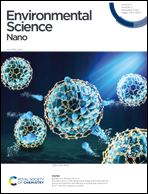Transition metal-doped MgO nanoparticles for nutrient recycling: an alternate Mg source for struvite synthesis from wastewater†
Abstract
Nutrient nitrogen (N) and phosphorus (P) recovery from wastewater is an important challenge for enhanced environmental sustainability. Herein we report the synthesis and properties of mesoporous MgO nanoparticles doped with copper (Cu), iron (Fe), and zinc (Zn) as an alternative low-solubility high-abundance magnesium (Mg) source for crystalline struvite precipitation from nutrient-laden wastewater. Undoped MgO was shown to have the fastest phosphate (PO43−) adsorption kinetics with a k2 value of 0.9 g g−1 min−1 at room temperature. The corresponding rate constant decreased for Cu–MgO (0.175 g g−1 min−1), Zn–MgO (0.145 g g−1 min−1), and Fe–MgO (0.02 g g−1 min−1). Undoped MgO resulted in the highest PO43− removal at 94%, while Cu–MgO, Fe–MgO, and Zn–MgO resulted in 90%, 66% and 66%, respectively, under equivalent reaction conditions. All dopants resulted in the production of struvite as the main product with the incorporation of the transition metals into the struvite crystal lattice. X-ray absorption spectroscopy (XAS) showed that the majority of the Cu, Fe, and Zn were primarily in the +2, +3, and +2 oxidation states, respectively. XAS also showed that the Cu atoms exist in elongated octahedral coordination, while Fe was shown to be in octahedral coordination. Zn was shown to be in a complex disordered environment with octahedral sites coexisting with the majority of the tetrahedral sites. Finally, X-ray photoelectron spectroscopy data suggest a two-fold struvite surface enrichment with dopant metals, with Cu exhibiting an interesting new local binding structure. The dopant concentrations utilized were consistent with those found in natural Mg minerals, suggesting that (a) utilizing natural mineral periclase as the Mg source for struvite production can result in struvite formation, albeit at the expense of the reaction kinetics and overall yields, while also (b) supplying essential micronutrients, such as Zn and Cu, necessary for balanced nutrient uptake.



 Please wait while we load your content...
Please wait while we load your content...